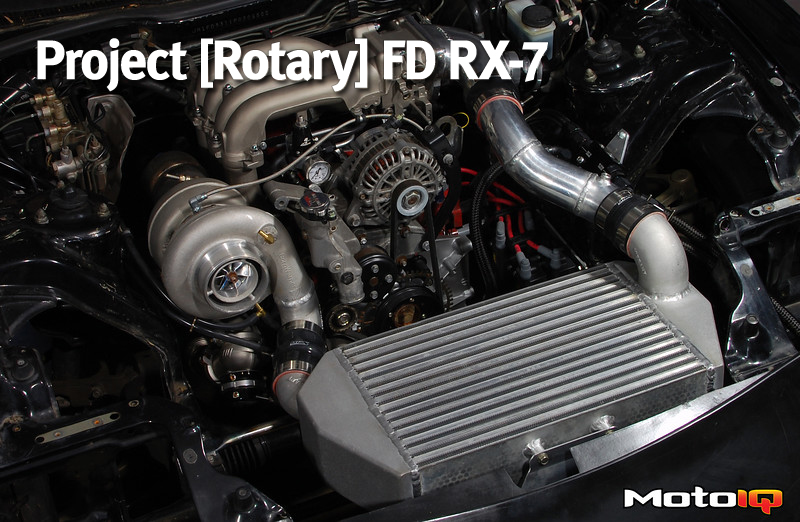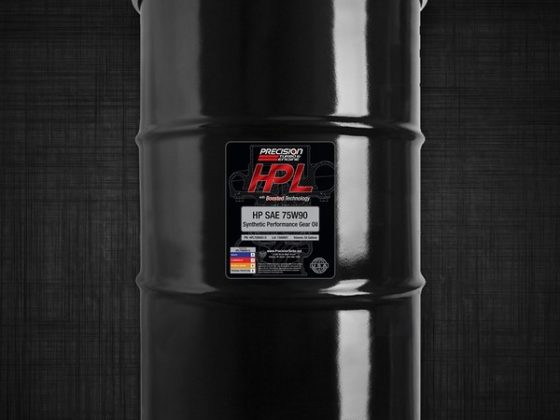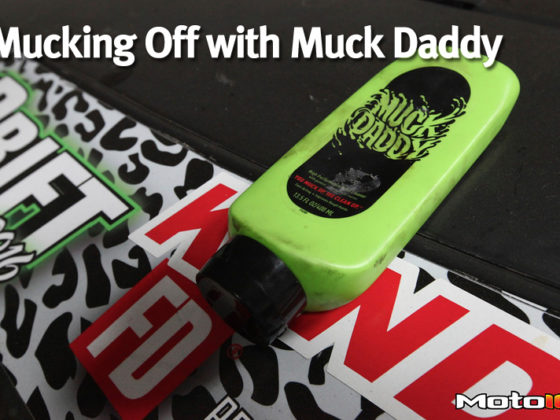,
Now that we have outlined what the plan is for the RX-7 radiator and intercooler, it's time to get to work and start designing the intercooler. We used cardboard, plywood, a 3D printer, liberal amounts of duct tape, and anything else we had lying around to do the initial mock-ups.
 The design work begins with some prototyping. If you look close you will notice the ultra-lightweight cardboard intercooler and futuristic 3D printed intake tubing. Below the intercooler is an extremely inefficient plywood radiator. In all seriousness, there are a lot of ways to prototype a design before purchasing materials and actually making parts. Here at MotoIQ we show no bias to the different forms of rapid prototyping.
The design work begins with some prototyping. If you look close you will notice the ultra-lightweight cardboard intercooler and futuristic 3D printed intake tubing. Below the intercooler is an extremely inefficient plywood radiator. In all seriousness, there are a lot of ways to prototype a design before purchasing materials and actually making parts. Here at MotoIQ we show no bias to the different forms of rapid prototyping.Once the general layout was known, it was time to select an intercooler core. For this we chose to go with a bar and plate unit from Garrett. Yes, the industry's most renowned turbocharger company also makes some of the best flowing and most thermally efficient intercooler cores in the business. All Garrett cores are hand made using bar and plate construction from aerospace grade aluminum alloy.
We started the core selection process by checking out Garrett's intercooler size chart on there website. On this chart there is advertised horsepower rating, overall dimensions, and weight for each core Garrett offers. Since space was the limiting factor in this build, we went with the biggest possible “frontal area” core we could fit to maximize heat rejection. When considering that end tanks would add a minimum of 3″ to each side of the core and that we had to fit a 4″ intake on one side of the intercooler, we ended up choosing a core that was 18″ wide and 12.1″ tall. The thickness choice was a bit more complicated and we'll get into that in a second, but first let's take a look at the core.
 The Garrett intercooler chosen for the RX-7 is hand made using bar and plate construction and measures a massive 18×12.1×4.5″. Intercooler cores don't seem like much in pictures, but you can rest assured knowing that it is a thing of beauty and is packed with a ton of performance potential.
The Garrett intercooler chosen for the RX-7 is hand made using bar and plate construction and measures a massive 18×12.1×4.5″. Intercooler cores don't seem like much in pictures, but you can rest assured knowing that it is a thing of beauty and is packed with a ton of performance potential. Back to core thickness which, as stated earlier, isn't always as straight forward as reading a horsepower rating chart and selecting a core based purely on horsepower requirements. Some people believe that a thicker intercooler core will cool better than a thinner core with the same cold-flow area, but I challenge those to go to Garrett's website (after finishing reading this article of course) and comparing two cores with the same width and height, but different thicknesses (say 3.5″ and 4.5″ thick). What you will find is that the two cores are rated for nearly the same horsepower. You might ask, how could this be and why would anyone choose the thicker, heavier core over the thinner one if both meet the horsepower requirements? The answer is pressure drop.
Pressure drop is the difference in pressure between the inlet and outlet of the intercooler. It is the easiest and most reliable way to tell if an intercooler is too small (in terms of hot-flow area). The reason that the two cores in the example above have similar horsepower ratings is because adding thickness to a core only helps thermal efficiency to a point, then suffers the wrath that is the law of diminishing returns. The real benefit of a thicker core is that it does not restrict air flow as much as a thinner core which in turn means that the turbo doesn't have to work as hard to produce the desired manifold pressure.
Again we'll get back to the intercooler physics discussion, but first let's take a look at the differences between a “budget” bar and plate intercooler and the Garrett unit and get a better idea of what we are talking about. The pictures below mostly speak for themselves, but it is a bit startling how much better the Garrett core looks.
 Comparing the hot-flow fin profile of the Garrett (left side) and uber-cheap “budget” (right side) intercooler cores and it isn't very hard to see that the difference is far from subtle. The core function of an intercooler is to remove heat and this is best done by increasing surface area. Garrett does this in two ways, they pack a ton of fins into each row and they stagger the fins through the core to break up the airflow. The one negative of such high fin density is that it reduces flow and increases pressure drop. Lucky for us Garrett accounts for this by utilizing wide hot-flow channels. You can see that the bargain intercooler has much smaller channels.
Comparing the hot-flow fin profile of the Garrett (left side) and uber-cheap “budget” (right side) intercooler cores and it isn't very hard to see that the difference is far from subtle. The core function of an intercooler is to remove heat and this is best done by increasing surface area. Garrett does this in two ways, they pack a ton of fins into each row and they stagger the fins through the core to break up the airflow. The one negative of such high fin density is that it reduces flow and increases pressure drop. Lucky for us Garrett accounts for this by utilizing wide hot-flow channels. You can see that the bargain intercooler has much smaller channels. The comparison between the intercoolers' cold-flow sides isn't much different than the hot-flow in terms of fin density and surface area. There is no doubt that the Garrett intercooler will outperform the budget intercooler handily.
The comparison between the intercoolers' cold-flow sides isn't much different than the hot-flow in terms of fin density and surface area. There is no doubt that the Garrett intercooler will outperform the budget intercooler handily.Okay, now let's finish up the intercooler physics discussion by taking a real world example of why pressure drop should be minimized. If we take a turbo car running at the track with a 90F turbo inlet air temperature and 1 bar of boost (manifold gauge pressure). Let's assume that there is 1psi of pressure drop across the intercooler and 1psi of pressure drop through the rest of the system. Let's also assume that the turbo is operating with a compressor efficiency of 72%. This would result in a turbo compressor outlet temperature of ~273F (yes, that hot). Now let's take all the same numbers except increase the intercooler pressure drop to 4psi (a very undersized intercooler) and assume compressor efficiency didn't decrease (unlikely). This would result in a compressor outlet temperature of ~298F. So the best case scenario is that the undersized intercooler has to compensate for an extra 25F compared to an intercooler that is sized properly. In short, it's good to remember that there are other things that need to be considered when choosing an intercooler core beyond heat transfer alone.
Now this intercooler core is undoubtedly the focal point of this portion of the project, but there are many components that are required to utilize a core like our Garrett unit. We need end tanks, tubing, couplings, and clamps. We also need to mount the damn thing and do a ton of fabrication to make it happen.
 Super thick, cast ATP intercooler end tank blanks are being used for this build. The primary reason for this is that the cast end tanks will be extremely robust and save a lot of design/fabrication time compared to custom sheet metal end tanks. There is so much fabrication required for this build that this reduction in workload is greatly appreciated.
Super thick, cast ATP intercooler end tank blanks are being used for this build. The primary reason for this is that the cast end tanks will be extremely robust and save a lot of design/fabrication time compared to custom sheet metal end tanks. There is so much fabrication required for this build that this reduction in workload is greatly appreciated.



12 comments
Every week I hope for an update. Any hope?
Hope…yes. How much? Not a lot for something soon. Long story short, I moved 2 years ago and the car was in a storage unit in a different state until 2 months ago. Finally have it with me, but currently have very little time to work. The project is still alive, just no where near the top of the priority list at the moment. Keep checking back and you’ll see something eventually :).
How much air should be split between the radiator and the intercooler?
Hi There,
Very nice Build!
I was wondering if you intercooler set up was going to be made available for purchase? or if I was able to purchase some cooler end caps from you.
Thanks
Rob
KISS. What are you building the car to do. looks like you have too much time and money, making the car
look flash but never driving it. looks like you don’t understand the RX-7.Sure there are shortfalls but all with much more cost effective solutions. and yes i do know what i’m talking about. Over 20,000 racing km’s beating factory backed Porsches. NO D.N.F.
Aren’t those NA 20b engines?
13B-REW sequential turbo
13B-REW sequential turbo and raced 1992-1998
Which class in what series and what power output?
I agree with KISS typically, but a 13B-REW sequential turbo probably isn’t going to be competitive in modern day time attack racing, which is what the car was originally being built for. Trying to keep a 450-500hp 13B happy without significant changes to the cooling system (oil, air, and water) is going to be very tough.
Sorry , Not trying to put you down, The car looked more like a show and dyno car. My experience is 450 hp tarmac rally car with competition from Germany backed Porsche 993 turbo 996 turbo . You are right you will have to
modify a few things and if you are serious about time attack maybe not the right place to discuss. i had to develop the car from scratch and was selling parts to mazdaspeed japan at one point and made quite a few mistakes along the way as well , I can see a few things that could help done different. I’m in Australia and no longer race these cars but will defend their underestimated ability i will shut up now . This is your project,
Always enjoyed the direction of this car. Any updates?